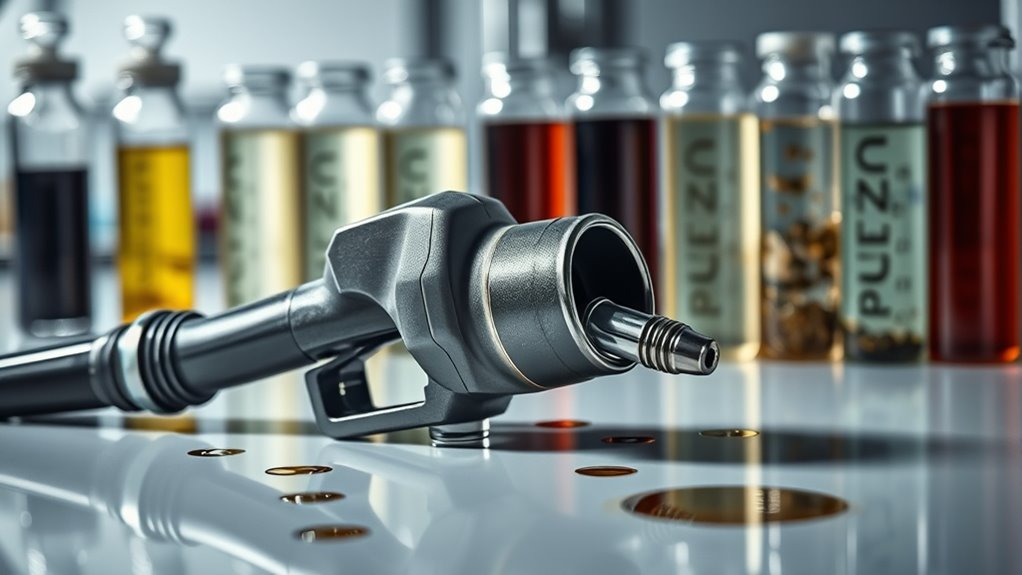To go from zero to confident about fuel quality, understand that visual checks can’t confirm purity, and contaminants like water and dirt often hide in fuel. Proper storage, choosing reputable stations, and avoiding false claims about additives will protect your engine. Ethanol blends are safe if handled correctly, and not all fuels are the same. Keep an eye out for common problems and maintenance tips—if you stay informed, you’ll keep your engine running smoothly and efficiently.
Key Takeaways
- Visual inspection alone cannot confirm fuel quality; contamination often occurs unseen.
- Contaminants like water and dirt can enter during refueling and cause engine damage.
- Proper storage and handling are essential to prevent fuel degradation and microbial growth.
- Reputable fuel stations and avoiding cheap fuels reduce contamination risks.
- Fuel additives’ effectiveness varies; regular maintenance and correct storage are more reliable for quality assurance.
Common Misconceptions About Fuel Quality

Many people believe that if the fuel looks clean and smells normal, it’s automatically of good quality. However, this is a common misconception fueled by contamination myths. Fuel additives are often marketed to improve engine performance, but their presence doesn’t guarantee quality or purity. Visual inspection isn’t enough to determine if fuel is contaminated or compromised. Contaminants like water or dirt can be invisible to the naked eye and may cause damage over time. Relying solely on appearance and smell can lead you to overlook potential issues that affect engine health. Instead, understanding that fuel quality involves more than just looks helps you make better choices and avoid problems caused by hidden contaminants. Proper fuel storage and handling are crucial for maintaining fuel integrity and preventing contamination issues.
How Fuel Contaminates Enter Your Vehicle
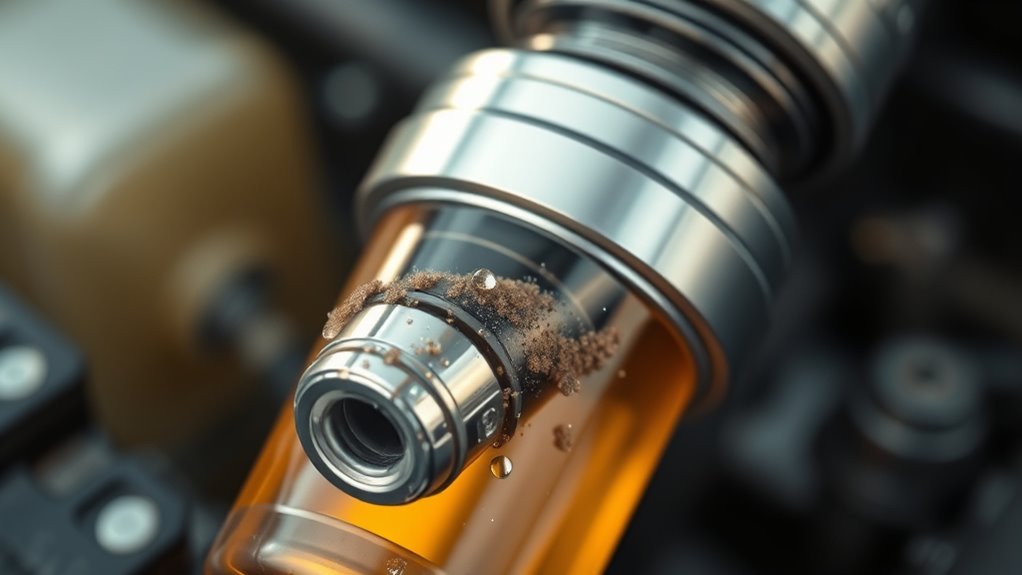
Have you ever wondered how contaminants like water, dirt, or debris find their way into your fuel system? Most often, these contamination sources enter through your fuel tank during refueling or from poor-quality fuel. When you fill up at a station, dust, dirt, or water can cling to the pump nozzle or be mixed with the fuel itself. Over time, these impurities settle at the bottom of your tank or circulate through your fuel lines. Additionally, aging or damaged seals and vents can allow moisture to seep in. Once inside, these contaminants can cause corrosion, clog filters, or damage your fuel injectors. Staying aware of these contamination sources and practicing proper fueling habits helps prevent debris from entering your vehicle and keeps your fuel system clean. Electric bikes and other innovative transportation options highlight the importance of maintaining clean and efficient energy systems.
The Truth About Additives and Fuel Treatments
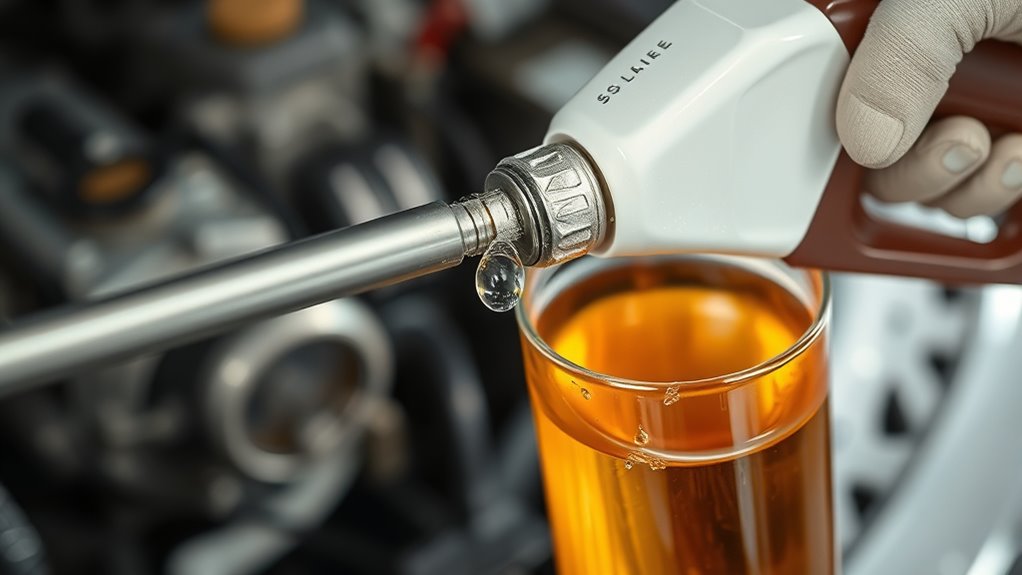
Fuel additives and treatments are often marketed as quick solutions to improve engine performance, cleanliness, and fuel efficiency. While some fuel additives can help keep your fuel system clean and reduce deposits, not all claims are backed by solid evidence. Many fuel treatments aim to prevent corrosion, stabilize fuel, or remove water, but their effectiveness varies. It’s important to understand that not every product delivers the promised benefits. Some additives may be unnecessary or even harmful if used improperly. Always choose reputable fuel additives and follow manufacturer instructions. Remember, maintaining good fuel quality starts with proper storage and regular vehicle maintenance, rather than relying solely on fuel treatments. Using the right fuel system components and ensuring your vehicle’s drivetrain is properly maintained can significantly impact performance. Use additives wisely to support your vehicle’s health, not as a quick fix.
Recognizing Fuel Quality Problems in Your Vehicle
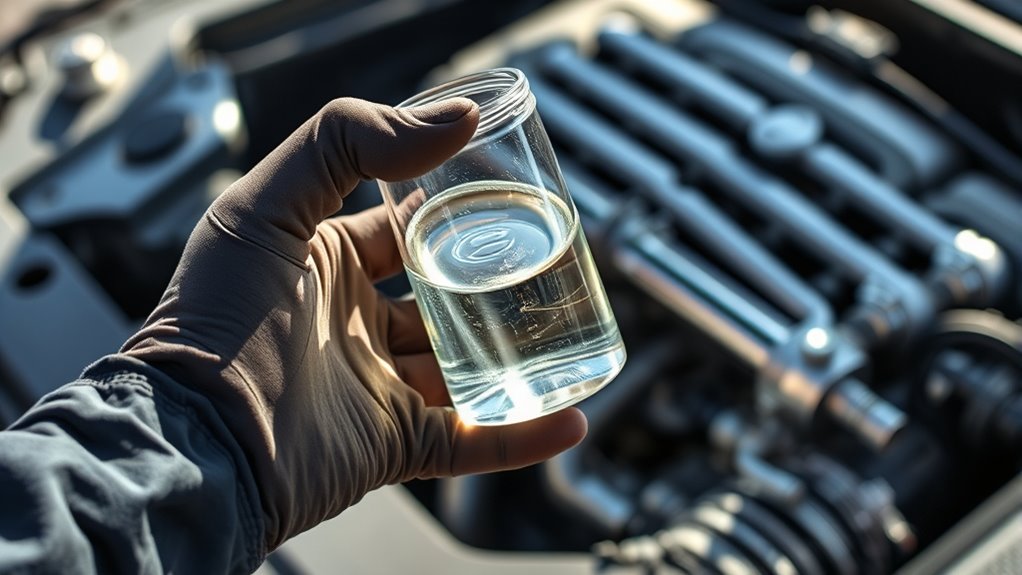
You might notice your vehicle stalls or runs roughly, which could signal fuel contamination. Poor fuel quality can also cause decreased acceleration or engine knocking. Recognizing these signs helps you catch problems early and keep your engine running smoothly. Regularly inspecting and maintaining your fuel system, including replacing filters and using quality fuel, can prevent contamination issues.
Signs of Fuel Contamination
How can you tell if your vehicle’s fuel has gone bad? One clear sign is a strange fuel odor—sour or chemical smells indicate contamination. Additionally, check the fuel color; fresh fuel is usually clear or slightly colored, but contaminated fuel may appear cloudy, darker, or murky. You might also notice your engine sputtering, hesitation, or rough idling, which are signs that something’s off with the fuel. If your vehicle stalls unexpectedly or experiences difficulty starting, contaminated fuel could be the culprit. Pay attention to these visual and sensory cues. Early detection helps prevent engine damage and costly repairs. Regularly inspecting the fuel in your tank for unusual smells or discoloration keeps your vehicle running smoothly and extends its lifespan. Understanding fuel quality and its impact on engine performance is crucial for vehicle maintenance.
Impact on Engine Performance
When fuel quality declines, your engine’s performance can quickly deteriorate, leading to noticeable issues during driving. Poor-quality fuel can cause your fuel injector to become clogged or less efficient, reducing the precision of fuel delivery. This disruption hampers combustion efficiency, resulting in rough idling, misfires, or decreased acceleration. You might also notice increased fuel consumption or engine knocking. Contaminants in low-quality fuel can lead to incomplete combustion, which strains engine components and diminishes overall power. Recognizing these signs early helps prevent long-term damage. Ensuring high-quality fuel maintains ideal fuel injector function and combustion efficiency, keeping your engine running smoothly and reliably. Proper fuel tuning can optimize performance and prevent contamination issues. Addressing fuel issues promptly preserves engine performance and saves you money on repairs.
Myths About Ethanol and Its Impact on Engines
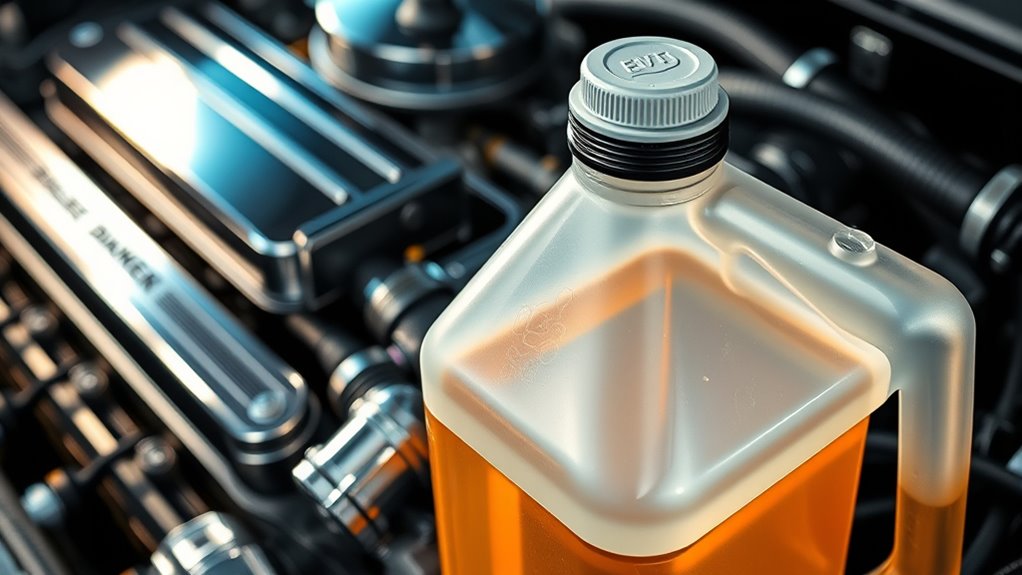
Many myths circulate about ethanol’s effect on engines, but not all are accurate. Some believe it harms engines or reduces fuel efficiency, while others think it’s worse for the environment than it really is. Let’s clarify these misconceptions to help you make informed decisions about ethanol-blended fuels. Understanding engine performance factors such as fuel quality and contamination prevention is essential for optimal vehicle operation.
Ethanol’s Effect on Engines
Despite common misconceptions, ethanol-blended fuels are generally safe for modern engines when used properly. The belief that ethanol causes significant engine damage is overstated. In reality, ethanol blends can be used without risking engine corrosion if your vehicle is maintained correctly. To understand ethanol’s effect on engines, consider these points:
- Ethanol absorbs water, which can lead to corrosion in fuel systems if ignored.
- Modern engines are designed to handle ethanol blends, reducing the risk of damage.
- Proper storage and regular maintenance prevent ethanol-related issues.
- Older engines may require additional care to avoid corrosion, but many modern models are compatible.
- Utilizing dog names that reflect your vehicle’s personality can make routine maintenance more enjoyable.
Myths About Fuel Efficiency
There’s a common misconception that using ethanol-blended fuels automatically reduces your vehicle’s fuel efficiency, but this isn’t entirely true. While ethanol can slightly lower fuel economy compared to pure gasoline, your driving habits play a bigger role in overall efficiency. Aggressive acceleration, speeding, and frequent stops can diminish your mileage more than the type of fuel you use. Modern engines are designed to handle ethanol blends effectively, so switching to E10 or E15 shouldn’t cause major issues if your vehicle is compatible. Instead of worrying about ethanol’s impact, focus on maintaining steady driving habits, keeping your tires properly inflated, and following regular maintenance schedules. These actions will do more to improve your fuel efficiency than the myth that ethanol drastically reduces your miles per gallon.
Environmental Impact Misconceptions
While concerns about ethanol’s environmental impact are common, some myths distort its true effects on engines and pollution. Many believe ethanol harms the environment, but in reality, it promotes emission reduction through cleaner combustion. Ethanol also supports fuel recycling by reducing reliance on fossil fuels. To clarify:
- Ethanol reduces greenhouse gases compared to gasoline.
- It encourages sustainable fuel practices without harming engine performance.
- Ethanol-blended fuels contribute to lower emissions.
- Proper use prevents contamination issues that could negate environmental benefits.
- Additionally, fuel contamination prevention is essential to maximize ethanol’s positive environmental impact and maintain engine longevity.
Understanding these facts helps you see ethanol’s role in eco-friendly fuel strategies. Dispelling misconceptions enables better decisions about fuel choices, emphasizing how ethanol can help protect our environment while maintaining engine health.
The Role of Proper Storage in Preventing Contamination
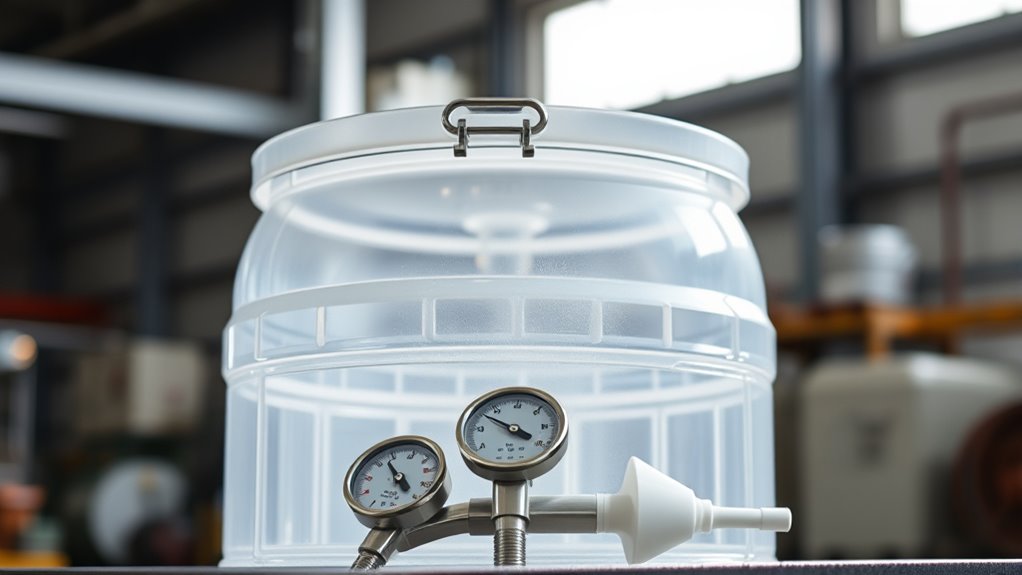
Proper storage plays a crucial role in preventing fuel contamination. When you store fuel correctly, you minimize the risk of dirt, water, and microbial growth that can compromise its quality. Choose sealed, airtight containers and keep them in a cool, dry location away from direct sunlight. Regularly inspect storage tanks for leaks or debris, and ensure vents are clean to allow proper airflow. Proper storage also involves using the right containers designed for fuel, preventing rust and corrosion that can introduce contaminants. By maintaining a clean, secure environment for your fuel, you support contamination prevention and preserve its quality over time. Using proper storage techniques helps minimize the risk of microbial growth and other contamination sources. Taking these simple steps ensures your fuel stays clean, reliable, and safe for use whenever you need it.
Debunking the Belief That All Fuel Is the Same

Many people assume that all fuel is the same because it appears similar and serves the same basic purpose. However, variations in fuel quality exist due to factors like refining processes and additives. To make informed choices, consider these points:
- Fuel labeling provides critical information about octane ratings and additives.
- Stations with a strong reputation often source higher-quality fuel.
- Cheaper fuels may contain more contaminants or lower-grade components.
- Consistently relying on reputable stations ensures better fuel consistency and fewer risks.
Understanding these differences helps prevent engine issues and maintains vehicle performance. Don’t rely solely on appearance; pay attention to fuel labeling and station reputation for safer, more reliable fuel consumption.
How to Choose Reliable Fuel Stations
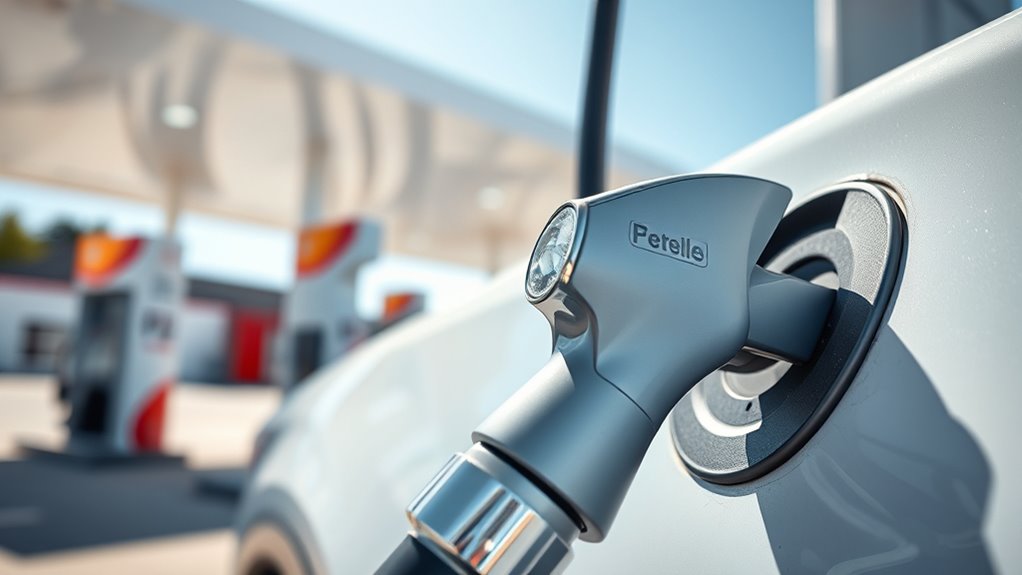
Choosing a reliable fuel station starts with paying attention to reputation and consistency. A station’s fuel station reputation reflects its commitment to quality and customer trust. Look for stations with positive reviews and a track record of clean, well-maintained pumps. Pricing transparency is equally important; avoid stations that frequently change prices or hide fees. Reliable stations clearly display their prices and don’t surprise you with hidden costs. Stick to well-known brands or local stations recommended by trusted sources, as they often adhere to stricter quality standards. Observe the station’s cleanliness and how staff handle fueling. Consistent quality and honest pricing help ensure you’re getting clean fuel, reducing the risk of contamination and engine trouble down the line.
The Importance of Regular Fuel System Maintenance
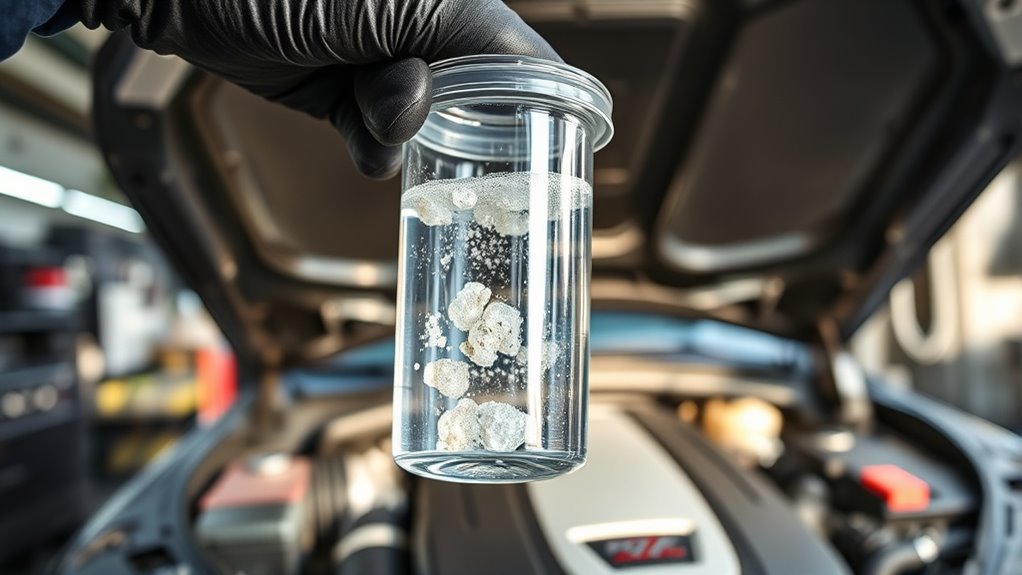
Regular fuel system maintenance is essential for keeping your engine running smoothly and preventing costly repairs. Proper upkeep includes using fuel additives to prevent buildup, especially if fuel sits during storage. Additionally, monitoring storage conditions—like avoiding extreme temperatures and moisture—helps maintain fuel quality. Here are four key steps:
- Regularly add fuel additives to prevent gum and varnish deposits.
- Use high-quality fuel to reduce contamination risks.
- Store fuel in sealed containers, away from heat and moisture.
- Periodically run your engine to circulate fresh fuel and prevent stagnation.
These practices ensure your fuel system stays clean and efficient, minimizing the need for repairs caused by contaminants or degraded fuel. Consistent maintenance keeps your engine reliable and prolongs its lifespan.
Simple Steps to Protect Your Engine From Contaminants
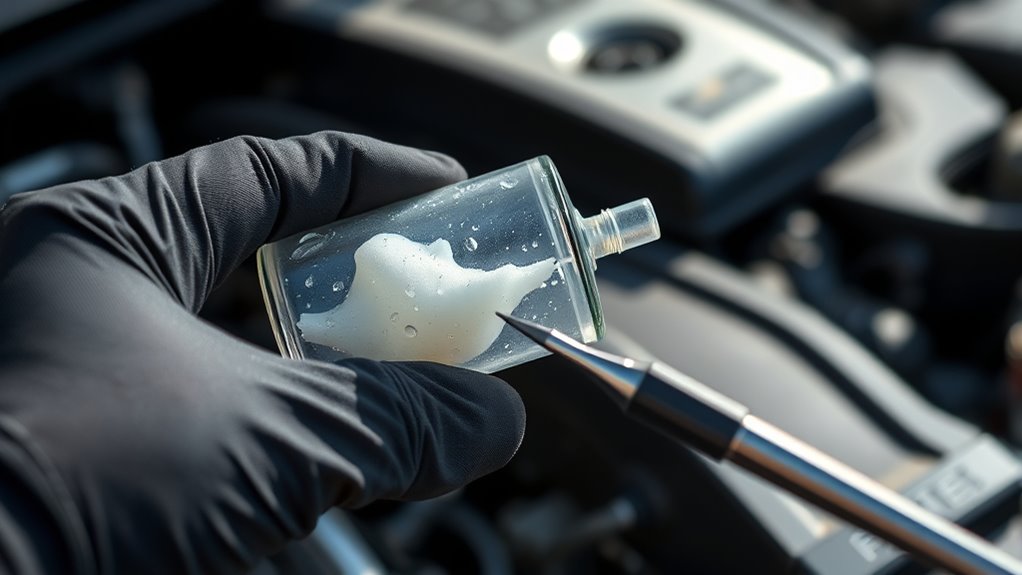
Contaminants in fuel can quickly harm your engine if you don’t take steps to prevent them. To protect your engine, use fuel additives designed to combat water and microbial growth, reducing the risk of contamination. Proper storage tips are essential—keep fuel in airtight containers, in a cool, dry place, and avoid exposure to sunlight. Regularly check and rotate stored fuel to prevent degradation. Consider this table for quick tips:
| Action | Why It Matters | Tips |
|---|---|---|
| Use fuel additives | Prevent microbial growth | Add every few tanks |
| Store fuel properly | Avoid contamination and degradation | Keep in sealed containers |
| Regular fuel checks | Detect issues early | Inspect and replace as needed |
Frequently Asked Questions
How Does Fuel Quality Affect Vehicle Emissions and Environmental Impact?
Your vehicle’s fuel quality directly impacts emission levels and pollution control. High-quality fuel burns more efficiently, reducing harmful emissions like CO2 and NOx. Poor-quality fuel causes incomplete combustion, increasing pollution and straining your vehicle’s systems. By using clean, certified fuel, you help lower your environmental impact, guarantee better engine performance, and support effective pollution control efforts. Better fuel choices lead to cleaner air and a healthier planet.
Can Poor Fuel Quality Cause Long-Term Engine Damage?
Poor fuel quality can definitely cause long-term engine damage. Contaminants like dirt, water, and degraded fuel can clog injectors and damage components, especially if you use improper storage practices. Fuel additives can help maintain fuel stability and cleanliness, but neglecting proper storage increases risks. Regularly testing and treating your fuel, along with good storage practices, guarantees your engine stays healthy and runs smoothly over time.
Are There Seasonal Variations in Fuel Contamination Risks?
Like a roller coaster, seasonal fluctuations can cause shifts in fuel contamination patterns, making risks vary throughout the year. During colder months, water and ice are more likely to settle in tanks, increasing contamination chances. Conversely, summer heat can promote microbial growth. Stay vigilant by inspecting fuel regularly, especially during seasonal changes, to prevent contamination and protect your engine. Recognizing these patterns helps you stay ahead of potential fuel issues.
What Signs Indicate My Fuel System Is Compromised?
If your fuel system is compromised, you’ll notice a strong fuel odor and possible engine misfire. You might also experience difficulty starting your vehicle, rough idling, or reduced power. These signs indicate contamination or fuel quality issues. Don’t ignore them—address the problem promptly to prevent further damage. Regular inspections and using quality fuel can help you avoid these issues altogether, keeping your engine running smoothly and efficiently.
How Do I Verify Fuel Quality at a New or Unfamiliar Station?
You verify fuel quality at a new or unfamiliar station by checking its reputation first. Look for reviews or ask fellow drivers about their experiences. Then, perform simple fuel testing if possible—inspect the fuel visually for clarity and contaminants, and consider using fuel testing kits for quality assurance. Trust reputable stations, and always stay alert for any signs of poor fuel to prevent engine issues down the line.
Conclusion
By understanding the myths and facts about fuel, you become the captain steering your vehicle through rough waters. Regular maintenance and choosing trusted stations are your navigational tools, helping you avoid hidden reefs of contamination. Think of your fuel system as your engine’s heartbeat—keeping it pure and healthy guarantees smooth sailing ahead. Stay informed, stay vigilant, and let your engine run confidently on a voyage free of myths and misconceptions.
